Search results for: 'Mitte'
-
 Ancient brooch of a fabulous creature
Ancient brooch of a fabulous creatureRare Hippocampus brooch with elaborate inlays of multi-coloured glass paste and metal. Great example of the brooch manufacturing of Roman Gaul during the mid 1st cent. AD.
Price: on request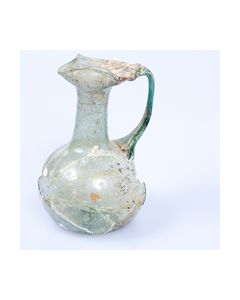 Glaskrug
GlaskrugKugelförmiger Körper, langer Hals mit bikonchaler Lippe, massiver Henkel.
Price: on request Römisches Unguentarium aus Glas
Römisches Unguentarium aus GlasFrei geblasenes Glasfläschchen für kostbare Flüssigkeiten wie Öl oder Parfüm. 1. Jh. v. Chr. bis 2. Jh. n. Chr., oströmische Provinz. Höhe 108 mm.
Price: on request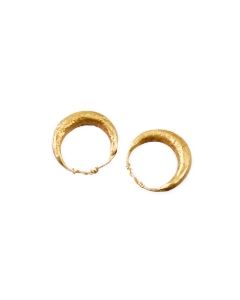 Graeco-Roman earrings
Graeco-Roman earringsThe pair of earrings is made of gold sheet. It is hollow inside. The type is from Northern Africa and dates to Greek or Roman times.
Price: on request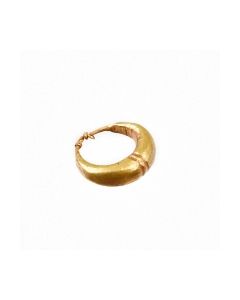 Graeco-Roman earring
Graeco-Roman earringThe decorated earrings is made of gold sheet. It is hollow inside. The type is from Northern Africa and dates to Greek or Roman times.
Price: on request Clay figurine of an Orans from the Fayum
Clay figurine of an Orans from the FayumAus dem Fayum. Kopf einer Frau mit rundem Gesicht, breiter Knollennase und wulstigem Hals. In den Ohren Löcher für Aufnahme von Ohrringen. Exzellent erhalten.
Price: on request Graeco-Roman earrings
Graeco-Roman earringsThe decorated pair of earrings is made of gold sheet. It is hollow inside. The type is from Northern Africa and dates to Greek or Roman times.
Price: on request Roman bronze strainer from "Museum fuer Morgenlandfahrer"
Roman bronze strainer from "Museum fuer Morgenlandfahrer"Large piece in very good condition with nice patina. On display in "Ex Oriente Lux" exhibition, published in the corresponding catalogue.
Price: on request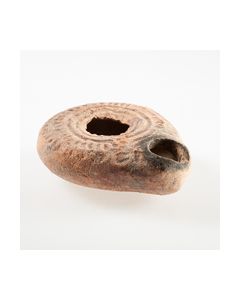 Spätrömische Öllampe aus dem Süden Israels
Spätrömische Öllampe aus dem Süden IsraelsHalbvoluten führen vom Brennloch zur Schulter, diese mit radialem Dekor.
Price: on request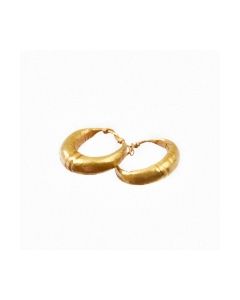 Graeco-Roman earrings
Graeco-Roman earringsThe decorated pair of earrings is made of gold sheet. It is hollow inside. The type is from Northern Africa and dates to Greek or Roman times.
Price: on request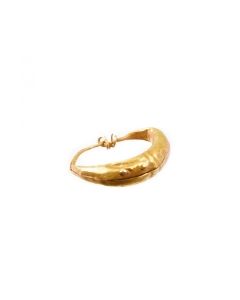 Graeco-Roman earring
Graeco-Roman earringThe decorated earrings is made of gold sheet. It is hollow inside. The type is from Northern Africa and dates to Greek or Roman times.
Price: on request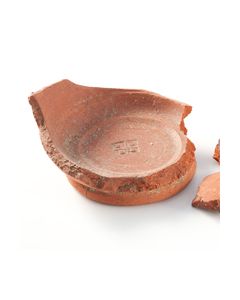 Terra Sigillata Boden mit Symbolstempel
Terra Sigillata Boden mit SymbolstempelStempel aus fünf Punkten, quadratisch angeordnet. Vom mittleren Punkt gehen vier Strahlen aus, welche einen stilisierten Stern bilden.
Price: on request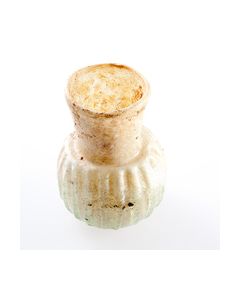 Römisches Glasfläschchen oder Kugelbecher
Römisches Glasfläschchen oder KugelbecherKleines Glasgefäß, typisch für antike Haushalte der Levanteküste. Römisch bis Spätrömisch. Mit elegantem Rippendekor an der Außenseite. 2. bis 5. Jh. n. Chr.
Price: on request Antike Münzform für Falschgeld - Fund aus Northamptonshire
Antike Münzform für Falschgeld - Fund aus NorthamptonshireGefunden in Pitchley, UK, am 1. Januar 2008. Der Fund ist mit PAS Nummer dokumentiert und wissenschaftlich untersucht. Von außerordentlicher Seltenheit.
Price: on request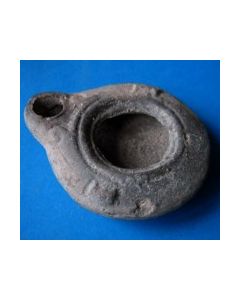 Römische Diskusförmige Öllampe
Römische Diskusförmige Öllampe1. bis 3. Jh. n.Chr., römische Epoche, Provinz Judäa. Hell-orangefarbene Keramik mit fast vollständigem dunklem Überzug. Wichtiger Lampentyp. Länge 71mm, Breite 60mm.
Price: on request Gallo-Roman animal fibula
Gallo-Roman animal fibulaZoomorphe Fibel mit Wildtier als Motiv. Schmuckstück mit religiöser Symbolik, vergleichbar einem Kreuzanhänger bei heutigen Christen. Gefertigt im 1. bis 3. Jh. n. Chr. in Gallien.
Price: on request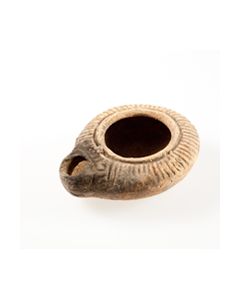 Spätrömische Öllampe vom Mamre-Typ
Spätrömische Öllampe vom Mamre-TypDas in der Bibel mehrfach erwähnte Mamre war u. a. der Wohnort Abrahams. Offene flache Lampe mit Halbvoluten.
Price: on request Römische Lampe mit Herstellerstempel
Römische Lampe mit HerstellerstempelGroße diskusförmige Öllampe. Stempel in Form von Blume / Kleeblatt in perfekter Erhaltung. 1. bis 3. Jh. n.Chr., wichtiger Lampentyp für Judäa. Länge 100mm, Breite 80mm.
Price: on request Provinzialrömische Fibel, Swastika
Provinzialrömische Fibel, SwastikaRömische Fibel aus Bronze, Swastika-Form, mit tierförmigen Enden aus stilisierten Pferdeköpfen. Soldatenfibel des 3. bis 4 Jh. n.Chr., Balkan-Raum.
Price: on request Römische Zwiebelknopffibel
Römische ZwiebelknopffibelMassive Zwiebelknopffibel aus Bronze. 23,2 Gramm, aus dem 4 Jh. n. Chr. Ungewöhnliche, kantige Zwiebelknopfverzierung.
Price: on request Geripptes römisches Glasfläschchen
Geripptes römisches GlasfläschchenKleines Glasgefäß, typisch für antike Haushalte der Levanteküste. Römisch bis Spätrömisch. Mit ungewohnter Abwandlung des Rippendekors. 2. bis 5. Jh. n. Chr.
Price: on request Provinzialrömische Fibel, Swastika
Provinzialrömische Fibel, SwastikaRömische Fibel aus Bronze, Swastika-Form, mit tierförmigen Enden aus stilisierten Pferdeköpfen. Soldatenfibel des 3. bis 4 Jh. n.Chr., Balkan-Raum.
Price: on request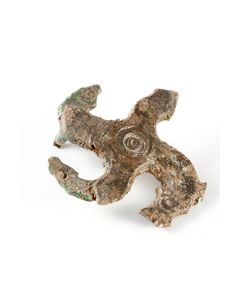 Provinzialrömische Fibel, Swastika
Provinzialrömische Fibel, SwastikaRömische Fibel aus Bronze, Swastika-Form, mit tierförmigen Enden aus stilisierten Pferdeköpfen. Soldatenfibel des 3. bis 4 Jh. n.Chr., Balkan-Raum.
Price: on request Provinzialrömische Fibel, Swastika
Provinzialrömische Fibel, SwastikaRömische Fibel aus Bronze, Swastika-Form, mit tierförmigen Enden aus stilisierten Pferdeköpfen. Soldatenfibel des 3. bis 4 Jh. n.Chr., Balkan-Raum.
Price: on request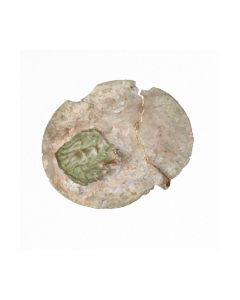 Ancient fibula from the Hattatt collection
Ancient fibula from the Hattatt collectionAncient fibula of the rare adlocutio type. Repoussé work of a scene from a Roman sestertius of Hadrian in celtic style. Find from Dorset in Roman Britain. Published in Hattatts famous book series on ancient fibulae.
Price: on request Roman provincial fibula of the horsemen
Roman provincial fibula of the horsemenThe swastika shaped brooch with horse head terminals was worn by the cavallery in Late Antiquity. In particular by the troops recruited by the Romans from their Pannonian Foederati. It might have been a symbol for strength or designated a military rank.
Price: on request Base of a Jupiter Column
Base of a Jupiter ColumnRepeatedly published base of a Jupiter Column from the Roman province Germania superior. Mid 2nd century AD to mid 3rd century AD. With extensive provenance going back to the 17th century.
€15,000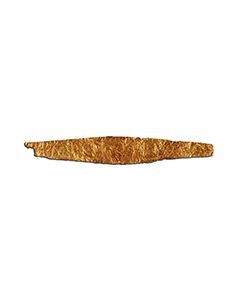 Roman gold diadem with bust of Licinius II
Roman gold diadem with bust of Licinius IIExciting and very well preserved piece.
Price: on request Published Roman fibula with celtic design
Published Roman fibula with celtic designAncient fibula from the Roman province of Britain. The design can be attributed to the celtic tribe of the Trinovantes or Iceni. From the famous Hattatt collection. Published twice.
Price: on request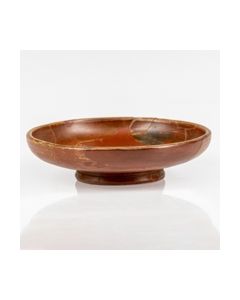 Roman Terra Sigillata bowl
Roman Terra Sigillata bowlFound in Southern Germany. From the well documented Hugo Rehorik collection.
Price: on request Two Roman jugs from the Rhineland
Two Roman jugs from the RhinelandFound 1966 till 1981 near the Roman city of Novaesium, today's Neuss in Germany. Novaesium was an early Roman foundation and with this is one of the oldest cities in Germany.
Price: on request Roman oil lamp with kissing lovers in mirror - parallel in a museum
Roman oil lamp with kissing lovers in mirror - parallel in a museumFrom the collection of Mr. Voigtmann, who had used the lamp. Moving relief in mirror, rare, possibly one of the rare original gallic motifs.
Price: on request Roman intaglio
Roman intaglioThis intaglio from Roman times shows a goddess in dynamic pose. The orange glass paste imitates carnelian.
Price: on request Roman square shaped glass paste
Roman square shaped glass pasteThe turquoise glass paste has two standing warriors as a motive. Simple work dating to Roman Imperial times.
Price: on request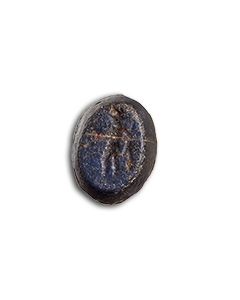 Ancient intaglio
Ancient intaglioA scene with a young man is moulded into dark blue glass. Insert stone dating to Roman Imperial times.
Price: on request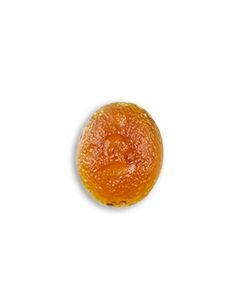 Roman intaglio with crouching woman
Roman intaglio with crouching womanThe woman is possibly a depiction of Venus. The orange colour of the glass paste is imitating Carnelian.
Price: on request

